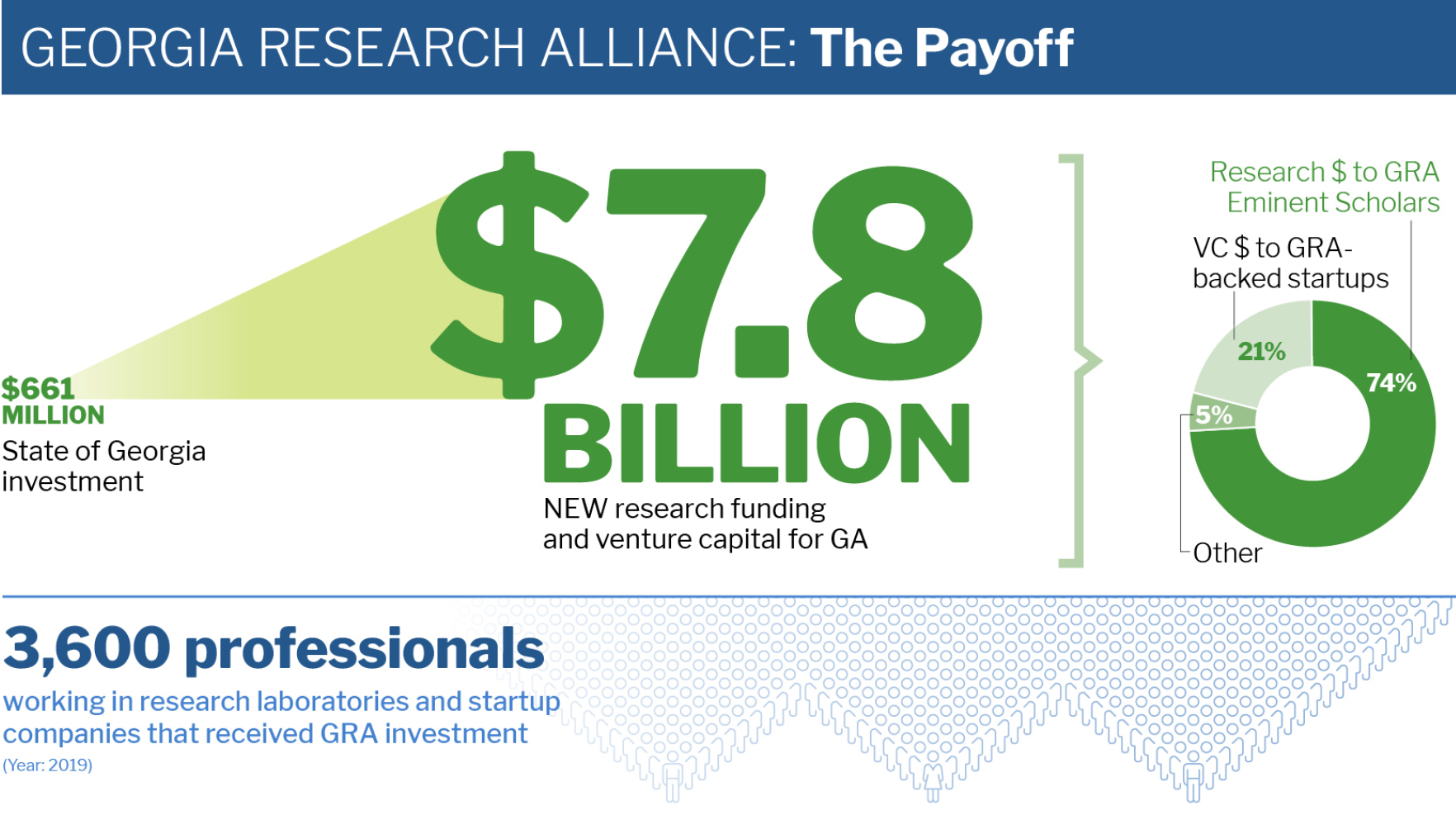

It wasn’t hatched in a lab, but there’s no doubt that the Georgia Research Alliance began as an experiment.
Thirty years ago, a handful of business leaders huddled with university presidents and an enterprising governor to shape a new kind of organization. Their idea was to leverage Georgia’s public and private universities to elevate the state’s profile in technology and innovation.
It was clearly a long-term play: By building up superstar scientific talent and state-of-the-art infrastructure inside the universities – in a coordinated way – the new alliance would speed discoveries and inventions coming out of the labs, the leaders believed.
Their prescience paid off. Each year, past investments made by GRA generate robust returns to Georgia. Some are measurable – hundreds of millions of new dollars in research and venture capital, plus jobs created in labs and startup companies.
Others are less tangible. Georgia’s research universities now collaborate at a level unsurpassed in the U.S., and GRA has super-sized the state’s innovation story in economic development efforts.

“Without question, GRA is a model of the benefit that can be created when government, academia and industry work together with a shared focus,” says David Ratcliffe, former chairman of The Southern Company and current chair of the Alliance. “But its past success is really only a starting point. GRA’s future potential to drive investment and bolster Georgia’s reputation is enormous.”
In its 30th anniversary year, which wraps in June 2021, GRA has published a few metrics to illustrate its impact:
Less precise is the impact GRA has had on Georgia’s reputation, though there are several indicators. More major companies, from semiconductors to soft drinks, are forging partnerships with Georgia’s university scientists. The state now ranks no. 11 in the U.S. in federal research funding; a top 10 ranking is within reach. And in their scientific fields, many GRA Eminent Scholars are highly acclaimed for making major advances and breakthrough discoveries.
In addition, GRA’s venture development program is a strong ally in university efforts to bring more inventions and discoveries to market. An example is the Innovation Gateway program at the University of Georgia: In just a few years, the commercialization program has propelled the launch of 200-plus startup companies, each built around UGA ingenuity. GRA has provided seed funding and strategic advice for many of them.
“By investing in research and entrepreneurship at Georgia’s universities, GRA has significantly added to our state’s economic development message,” says Pat Wilson, commissioner of the Georgia Department of Economic Development. “Companies want to be in close proximity to high-quality research universities and to a talented workforce. By delivering both, GRA has helped us attract businesses of all sizes to expand or establish a presence in Georgia and create jobs in every region of the state.”
“GRA’s impact on Georgia’s reputation is hard to measure, but it’s very real,” says Claude Wade, a GRA trustee who heads Client Experience and the Atlanta Office (and serves as Innovation Hub Leader) for global asset manager BlackRock. “In 2018, we chose to expand our global footprint in Georgia because of an abundance of technology talent and the vibrant start up ecosystem. The exponential growth of research at the state’s universities has been key to growing that talent.”

Getting the universities to work together has proven to be another benefit of GRA’s formation. Much of the collaboration has been informal: Having a vehicle for scientists to get to know each other has led to joint research projects and themed seminars across universities. But some collaboration has been by design.
For example, GRA was an early investor in an effort by a public and private university – Georgia Tech and Emory – to start a biomedical engineering department together. Founded in 1997, the Wallace H. Coulter Department undergraduate program now ranks no. 2 in the nation and has an enviable research portfolio. Over the years, three GRA Eminent Scholars have chaired the department.
In 2019, GRA also helped launch the GRA Core Exchange, a program that allows a scientist at any university to use research facilities and high-tech equipment at all of the other universities. To facilitate access, the nine participating universities pooled their inventory of instrumentation into a searchable online database. They also agreed to waive administrative overhead fees.
“By investing in talent and infrastructure, GRA has played a pivotal role in Georgia State University’s meteoric rise as a research institution,” says GSU President Mark Becker. “And we’re not alone. GRA has shown to be an invaluable ally for all of Georgia’s research universities. I am proud of our partnership with GRA and what we have accomplished together during my tenure as President of Georgia State.”

The impetus for business, government and university leaders moving to launch GRA 30 years ago followed what was a lost opportunity for Georgia.
In 1983, the state failed to win a headquarters bid for a large industry consortium seeking a place to develop the next generation of semiconductor technology. The consortium – Microelectronics Computer and Technology Corporation – instead located in Austin, where it jump-started the city’s fledgling tech industry and established a high-tech hub.
The critical factor in Austin’s win was a public-private partnership that combined government resources and private sector energy and creativity. Georgia leaders quickly realized the competitive advantage of having a technology alliance that leveraged state dollars to expand university research capacity.
In 1990, a group of Georgia leaders established GRA as a nonprofit to help business, research universities and state government collaborate to build a tech-driven economy fueled in part by university research.
Real estate developer Tom Cousins factored prominently in the effort. So did the late Lawrence L. Gellerstedt, Jr. – he had chaired the Georgia Research Consortium, the state’s 1980s-era attempt at a technology authority and was named GRA’s founding chairman. They and others worked with then-Gov. Zell Miller, who recognized GRA could be an instrument to strengthen higher education research and tech-based economic development. Miller recommended funding for the new independent Alliance.
Those early roots are still visible in the GRA of today.
“Tom Cousins remains an emeritus trustee, and the Gellerstedt family's involvement continues with Larry Gellerstedt III, a current trustee and past chair,” notes Ratcliffe. “The same is true of the Russell family. Herman was on that first Board of Trustees, and his son Michael serves today. And an initial $500,000 grant to establish GRA's operations came from the Robert W. Woodruff Foundation, which back then was led by Pete McTier, our current secretary/treasurer.”